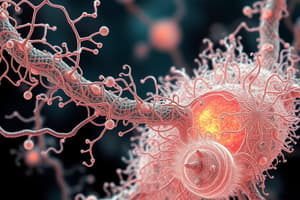Podcast
Questions and Answers
What is the primary function of apoptosis?
What is the primary function of apoptosis?
- To reduce energy consumption
- To increase the size of the organism
- To destroy cells that are dangerous to the rest of the organism (correct)
- To allow cells to reproduce more efficiently
Why do scientists study apoptosis intensively?
Why do scientists study apoptosis intensively?
- Because it can prevent cancer and lead to diseases if problematic (correct)
- Because it is a cure for cancer
- Because it is a natural process
- Because it only occurs in humans
What happens when a cell's DNA is badly damaged?
What happens when a cell's DNA is badly damaged?
- The cell becomes stronger
- The cell transforms into a cancer cell
- The cell reproduces itself
- The cell triggers apoptosis pathways (correct)
What is a challenge in developing drugs to induce apoptosis in cancer cells?
What is a challenge in developing drugs to induce apoptosis in cancer cells?
What can happen when essential genes required for apoptosis are damaged?
What can happen when essential genes required for apoptosis are damaged?
What is an example of a beneficial outcome of apoptosis?
What is an example of a beneficial outcome of apoptosis?
What is the outcome when damaged cells do not undergo apoptosis?
What is the outcome when damaged cells do not undergo apoptosis?
Why is apoptosis an important evolutionary adaptation?
Why is apoptosis an important evolutionary adaptation?
What is the primary focus of the science of biochemistry?
What is the primary focus of the science of biochemistry?
What is a biomarker?
What is a biomarker?
What is the primary function of calmodulin?
What is the primary function of calmodulin?
What is the main driver of the increased levels of carbon in the Earth's systems?
What is the main driver of the increased levels of carbon in the Earth's systems?
What is the process by which autotrophic organisms use carbon dioxide?
What is the process by which autotrophic organisms use carbon dioxide?
What is the result of excess carbon dioxide being absorbed by the ocean?
What is the result of excess carbon dioxide being absorbed by the ocean?
What is the basic unit of life?
What is the basic unit of life?
What is the role of troponin C in the cell?
What is the role of troponin C in the cell?
What is the primary energy storage molecule in cells?
What is the primary energy storage molecule in cells?
What is the purpose of anabolic reactions in cells?
What is the purpose of anabolic reactions in cells?
What is the role of chromogen in microbiology?
What is the role of chromogen in microbiology?
What is the function of CRISPR/Cas9 system?
What is the function of CRISPR/Cas9 system?
What is the difference between coenzymes and cofactors?
What is the difference between coenzymes and cofactors?
Why do catabolic and anabolic pathways often inhibit each other?
Why do catabolic and anabolic pathways often inhibit each other?
What is the result of catabolic reactions breaking down nutrients and food?
What is the result of catabolic reactions breaking down nutrients and food?
What is the purpose of separating metabolic pathways into different organelles in eukaryotes?
What is the purpose of separating metabolic pathways into different organelles in eukaryotes?
What is the primary function of coenzyme A in initiating fatty acid production?
What is the primary function of coenzyme A in initiating fatty acid production?
What is the result of the electron transport chain in relation to ATP?
What is the result of the electron transport chain in relation to ATP?
What is the primary source of coenzymes in most organisms?
What is the primary source of coenzymes in most organisms?
What is the role of non-vitamin coenzymes in an organism?
What is the role of non-vitamin coenzymes in an organism?
What is the relationship between coenzymes and vitamins?
What is the relationship between coenzymes and vitamins?
What is the consequence of insufficient vitamin intake on coenzyme production?
What is the consequence of insufficient vitamin intake on coenzyme production?
What is the primary function of ATP in an organism?
What is the primary function of ATP in an organism?
What is the relationship between coenzyme A and vitamin B5?
What is the relationship between coenzyme A and vitamin B5?
What is the primary mechanism by which fungi obtain nutrients from their environment?
What is the primary mechanism by which fungi obtain nutrients from their environment?
What is the term for a fungus that obtains nutrients from dead organic matter?
What is the term for a fungus that obtains nutrients from dead organic matter?
What is the result of fermentation in terms of ATP production?
What is the result of fermentation in terms of ATP production?
What is the purpose of the rhizomorphs in fungi?
What is the purpose of the rhizomorphs in fungi?
What is the term for the study of fermentation and its practical uses?
What is the term for the study of fermentation and its practical uses?
What is the result of the metabolic process of fermentation?
What is the result of the metabolic process of fermentation?
What is the purpose of the symbiotic relationship between a fungus and a photosynthetic organism?
What is the purpose of the symbiotic relationship between a fungus and a photosynthetic organism?
What is the term for a symbiotic association between a fungus and an animal that photosynthesizes?
What is the term for a symbiotic association between a fungus and an animal that photosynthesizes?
Flashcards
Apoptosis
Apoptosis
Programmed cell death that eliminates damaged or unnecessary cells.
Apoptosis and Cancer Prevention
Apoptosis and Cancer Prevention
Apoptosis plays a crucial role in preventing cancer by eliminating damaged cells that could become cancerous.
Apoptosis and DNA Damage
Apoptosis and DNA Damage
Damaged DNA triggers apoptosis pathways, preventing the spread of mutations.
Apoptosis and Disease
Apoptosis and Disease
Signup and view all the flashcards
Biochemistry
Biochemistry
Signup and view all the flashcards
Biomarker
Biomarker
Signup and view all the flashcards
Calmodulin
Calmodulin
Signup and view all the flashcards
ATP (Adenosine Triphosphate)
ATP (Adenosine Triphosphate)
Signup and view all the flashcards
Anabolic Reactions
Anabolic Reactions
Signup and view all the flashcards
Chromogen
Chromogen
Signup and view all the flashcards
CRISPR/Cas9 System
CRISPR/Cas9 System
Signup and view all the flashcards
Catabolic Reactions
Catabolic Reactions
Signup and view all the flashcards
Coenzyme
Coenzyme
Signup and view all the flashcards
Coenzyme A
Coenzyme A
Signup and view all the flashcards
Electron Transport Chain
Electron Transport Chain
Signup and view all the flashcards
Fungal Nutrient Acquisition
Fungal Nutrient Acquisition
Signup and view all the flashcards
Saprobe
Saprobe
Signup and view all the flashcards
Fermentation
Fermentation
Signup and view all the flashcards
Rhizomorphs
Rhizomorphs
Signup and view all the flashcards
Zymology
Zymology
Signup and view all the flashcards
Lichen
Lichen
Signup and view all the flashcards
Photosynthesis
Photosynthesis
Signup and view all the flashcards
Cell
Cell
Signup and view all the flashcards
Troponin C
Troponin C
Signup and view all the flashcards
Human Impact on Carbon Levels
Human Impact on Carbon Levels
Signup and view all the flashcards
Ocean Acidification
Ocean Acidification
Signup and view all the flashcards
Cofactor
Cofactor
Signup and view all the flashcards
Coenzyme vs Cofactor
Coenzyme vs Cofactor
Signup and view all the flashcards




